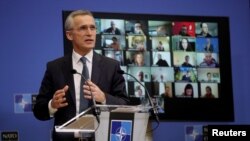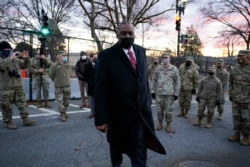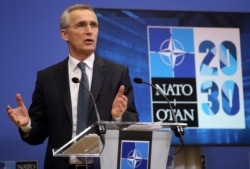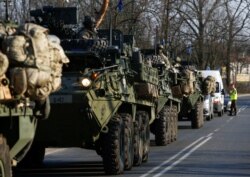U.S. Defense Secretary Lloyd Austin will be using his first ministerial meeting with NATO allies Wednesday to try to repair the frayed relationship, acknowledging that long-standing ties were, at times, strained under former U.S. President Donald Trump.
The change in tone and approach, as senior U.S. defense officials described it Tuesday, comes as the United States and NATO are staring down major decisions on force levels in Afghanistan and on how to best confront powers like Russia and China, which remain set on bending international norms in their favor.
But Austin intends to make the case that the ability to make progress on any of the pressing issues facing the alliance depends on putting the relationship back on solid footing.
“Teams succeed only when every player is trusted and respected. And our alliance teammates haven’t always felt that respect,” the defense secretary wrote in an op-ed published late Tuesday by The Washington Post.
“We must consult together, decide together and act together,” he added.
Austin and senior defense officials said the process of revitalizing the U.S. relationship with NATO began immediately, with calls going to NATO Secretary-General Jens Stoltenberg and other alliance members, many of whom felt somewhat abandoned by the previous administration.
"It is fair to say that over the last four years, the public perception of the U.S. commitment and our intent have been a little bit unclear," a senior U.S. defense official told reporters ahead of the start of two days of virtual meetings.
Austin “is really focused on trying to revitalize our relationship with the alliance,” the official said, adding the secretary intends to assure NATO that Washington’s commitment to mutual defense, referred to as Article 5 under the treaty, “remains ironclad.”
NATO Secretary-General Jens Stoltenberg signaled a desire to reset the U.S.-NATO relationship earlier this month.
“There's no denying that over the last four years, we had some challenging times. And there's no secret that also I had some difficult discussions with the former president,” he said. “It is in the security interests of both Europe and North America, the United States, to start again.”
Yet while the Biden administration and NATO seek to mend any lingering rifts, they are being confronted by their first major decision — what to do in Afghanistan, where the U.S. faces a May deadline for withdrawing its remaining 2,500 troops from the country.
Afghanistan
“There have not been any decisions on Afghanistan troop levels," the senior defense official said, calling the NATO ministerial a chance for the U.S. to consult with alliance members, who have another 7,000 troops stationed there.
"The United States and NATO went into Afghanistan together. We will adjust together. And if the time is right, we will leave together," the official added, echoing comments from the NATO secretary general just a day earlier.
Concerns, though, have been growing that the deal signed with the Taliban may not be sustainable.
U.S. defense officials have repeatedly warned that the level of violence in Afghanistan remains too high, raising questions about whether the Taliban are truly holding up their end of the bargain.
Some U.S. officials remain hopeful.
“I think there's every incentive for them to live up to that agreement,” a second senior U.S. defense official said of the Taliban, noting the Pentagon is still conducting a review of the February 2020 agreement.
But some analysts do not see the U.S. agreeing to leave just yet.
The Biden administration “wants to preserve stability in Afghanistan and to make sure that the counterterrorism mission that brought the United States to Afghanistan in 2001 continues,” Steve Coll, author of “Ghost Wars: The Secret History of the CIA, Afghanistan, and Bin Laden,” told VOA’s Afghan service via Skype.
“I think they're most likely to conclude that they need more time and that the level of troops in Afghanistan, now 2,500 or so, might not be enough for the counterterrorism mission,” Coll said.
US forces in Europe
Washington’s NATO allies are also going to want to hear about the fate of U.S. troops currently stationed across Europe.
Under the direction of Trump, the U.S. announced last July it would be pulling about 12,000 troops from Germany, sending some of them to Belgium, Italy and Poland, while bringing the rest back home.
Under Biden, that plan has been put on hold. And Washington is likely to assure allies that at the least, U.S. forces will not be pulling back.
"I would in no way expect to see anything that would look like, say, a withdrawal," a senior U.S. defense official said. "The posture in Europe is critical to U.S. national security interests."
Russia
Along with assuring U.S. European allies of a continued U.S. presence, defense officials will also prioritize standing up to Russia.
“Revitalizing the U.S. relationship with the alliance, a change in our tone and approach, a desire to work with our allies and partners … that is all inextricably tied to what we have seen from Russia,” the senior defense official said.
Defense spending
One area where there is likely to be some degree of continuity from the Trump administration to the Biden administration is on defense spending.
Pentagon officials said Tuesday while they are appreciative of the NATO allies who have made good on the alliance-wide pledge for all members to spend 2% of their gross domestic product (GDP) on defense, it is not enough.
"We expect all allies to live up to this commitment," the senior defense official said. “There's more work to be done ... you're going to very much hear that."
VOA Afghan service contributed to this report.











